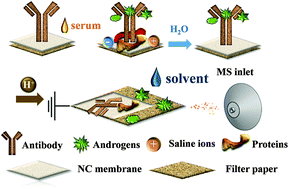The simultaneous quantitative detection of multiple hormones based on PS-MS: affinity capture by a single antibody†
Abstract
Steroid hormones play important roles in metabolism and metabolic diseases. Currently, various detection methods are employed in clinical labs, mainly immunoassays and LC-MS/MS, but these methods suffer from antibody cross-reactivity or the need for complex LC processes, respectively. Here, we utilized single antibody to capture and separate multiple hormones from samples to avoid LC procedures and used MS/MS to analyze multiple molecules in a single run. In our strategy, testosterone (T), androstenedione (4-AD), and androsterone (ADT) were affinity-captured simultaneously using only T antibody. The qualitative and quantitative analysis of three androgens was realized through MS/MS spectra using testosterone-D3 (T-D3) as an internal standard. Standard curves for standard solution or spiked serum samples were realized in the range of 0.01–2 μg L−1. The LODs for the three androgens were 2.3 × 10−3 μg L−1 for testosterone, 4.6 × 10−3 μg L−1 for androstenedione, and 2.8 × 10−3 μg L−1 for androsterone. The recovery results verified the reliability and stability of our method. This strategy has widespread potential for advancing the combination of immunoassay and MS methods in the analysis of small molecules, with high through-put and low cost.



 Please wait while we load your content...
Please wait while we load your content...